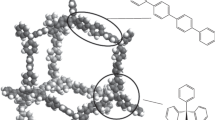Abstract
Methanol vapor permeability and pore formation features in stretched polytetrafluoroethylene (PTFE) films used as a precursor of composite cation-exchange membranes have been studied. Porous structures of the precursor have been formed via stretching PTFE films in air, toluene, isopropyl alcohol, and CCl4. Permeability has been determined according to the evaporation of a liquid through a porous film; porosity, according to the increase in the film volume during stretching; pore formation features, according to optical microscopy images of porous films and their transverse microsections. It has been found that, with an increase in the stretch ratio, the porosity of PTFE films increases almost linearly, while the methanol vapor permeability increases exponentially. The permeability of the films stretched in liquids is 20 times higher than the permeability of the films stretched in air at comparable stretch ratio and porosity values. The considerably higher permeability of the films stretched in liquids and the observed differences in their porous structure suggest that the liquids are actively involved in the formation of through pores in the direction connecting the film surfaces, i.e., in the direction that determines the transport and conductive properties of composite membranes based on stretched PTFE films.
Similar content being viewed by others
References
M. Nasef, Prog. Polym. Sci. 29, 499 (2004).
S. A. Gursel, L. Gubler, B. Gupta, and G. G. Scherer, Adv. Polym. Sci. 215, 157 (2008).
M. M. Nasef, Chem. Rev. 114, 12278 (2014).
S. Homberg, J. H. Nasman, and F. Sundholm, Polym. Adv. Technol. 9, 121 (1998).
Z. Zhang, E. Chalkova, M. Fedkin, et al., Macromolecules 41, 9130 (2008).
M. M. Hassan, L. Wu, Y. Li, et al., Sep. Purif. Technol. 150, 102 (2015).
E. Yu. Safronova, D. V. Golubenko, N. V. Shevlyakova, et al., J. Membr. Sci. 515, 196 (2016).
D. V. Golubenko and A. B. Yaroslavtsev, Mendeleev Commun. 27, 572 (2017).
E. F. Abdrashitov, V. Ch. Bokun, D. A. Kritskaya, et al., Solid State Ionics 251, 9 (2013).
A. N. Ponomarev, E. F. Abdrashitov, D. A. Kritskaya, et al., Russ. J. Electrochem. 53, 589 (2017).
E. F. Abdrashitov, D. A. Kritskaya, V. Ch. Bokun, and A. N. Ponomarev, Russ. J. Phys. Chem. B 10, 820 (2016).
E. F. Abdrashitov, D. A. Kritskaya, V. C. Bokun, et al., Solid State Ionics 286, 135 (2016).
E. A. Sinevich, I. V. Bykova, S. N. Chvalun, and N. F. Bakeev, Polym. Sci., Ser. A 39, 1222 (1997).
G. K. Elyashevich, I. S. Kuryndin, V. K. Lavrentyev, et al., Phys. Solid State 54, 1907 (2012).
D. V. Novikov, I. S. Kuryndin, and G. K. Elyashevich, Phys. Solid State 57, 1028 (2015).
A. L. Volynskii, E. M. Ukolova, E. A. Shmatok, et al., Dokl. Akad. Nauk SSSR 310, 380 (1990).
A. L. Volynskii, E. A. Shmatok, E. M. Ukolova, et al., Vysokomol. Soedin., Ser. A 33, 1004 (1991).
S. V. Timofeev, L. P. Bobrova, E. I. Terutskii, et al., Al’tern. Energ. Ekol., No. 2, 128 (2007).
L. M. Yarysheva, L. Yu. Pazukhina, G. M. Lukovkin, et al., Vysokomol. Soedin., Ser. A 24, 2149 (1982).
L. M. Yarysheva, L. Yu. Pazukhina, N. M. Kabanov, et al., Vysokomol. Soedin., Ser. A 26, 388 (1984).
G. M. Lukovkin, L. Yu. Pazukhina, L. M. Yarysheva, et al., Vysokomol. Soedin., Ser. A 28, 189 (1986).
A. L. Volynskii, O. V. Kozlova, and N. F. Bakeev, Vysokomol. Soedin., Ser. A 28, 2230 (1986).
E. A. Sinevich, M. S. Arzhakov, M. A. Krykin, et al., Vysokomol. Soedin., Ser. A 30, 969 (1988).
M. P. Rodgers, Z. Shi, and S. Holdcroft, J. Membr. Sci. 325, 346 (2008).
Author information
Authors and Affiliations
Corresponding author
Additional information
Original Russian Text © D.A. Kritskaya, E.F. Abdrashitov, V.Ch. Bokun, A.N. Ponomarev, 2018, published in Membrany i Membrannye Tekhnologii, 2018, Vol. 8, No. 2, pp. 107–115.
Rights and permissions
About this article
Cite this article
Kritskaya, D.A., Abdrashitov, E.F., Bokun, V.C. et al. A Study of Pore Formation and Methanol Vapor Permeability in Stretched Polytetrafluoroethylene Films Used as a Precursor of Composite Ion-Exchange Membranes. Pet. Chem. 58, 309–316 (2018). https://doi.org/10.1134/S0965544118040059
Received:
Published:
Issue Date:
DOI: https://doi.org/10.1134/S0965544118040059




